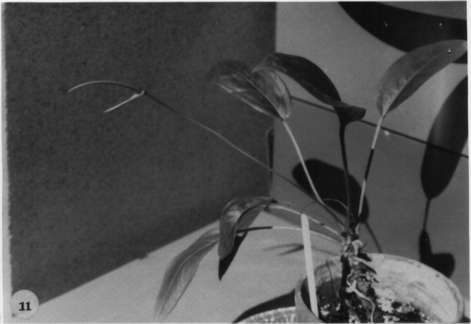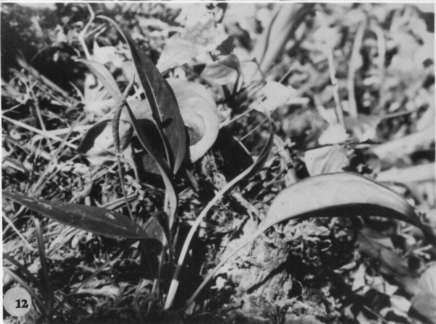





Anthurium austin-smithii Croat & Baker,
Brenesia 16 (Supl. I): 25. 1979. TYPE: Costa Rica. Alajuela: San Luis de Zarcero, elev. 1,450 m, Austin Smith 637 (NY, holotype;F, isotype).
Epiphyte; roots numerous, slender, green drying grayish; stem moderately elongate, ca. 1 cm diam., 16-20 cm long, scurfy; cataphylls 2-2.5 cm long, drying dark reddish-brown, persisting as linear fibers.
LEAVES spreading; petioles subterete, narrowly sulcate, 4-22 cm long, 2-4 mm diam.; geniculum 7-20 mm long; blades subcoriaceous, oblong-lanceolate, 11-21 cm long, 3-6.5 cm wide, long-acuminate at apex (the acumen flat), obtuse to acute (rarely attenuate) at base, broadest at or below the middle, the margin revolute on drying; both surfaces semiglossy, lower surface dark glandular-punctate; midrib acutely raised above, diminished and sunken toward apex, convexly raised below; primary lateral veins 7-15 per side, departing midrib at 45° angle, ± straight to the collective vein, slightly sunken above, promi-nulous below; interprimary veins sunken above, scarcely visible below; collective vein arising from the base, 4-8 mm from the margin, about equally as prominent as the primary lateral veins, sunken above, prominulous and darker below.
INFLORESCENCE erect-spreading, equalling or exceeding the leaves; peduncle terete to sharply an-gulate, 2-3-ribbed, sometimes with only one rib, 21-25 cm long, 2-3 mm diam.; spathe pale green, lanceolate, 2.5-3 cm long, 4-8 mm wide, broadest just above the base, acuminate at apex, rounded at base, inserted at ca. 30° angle on the peduncle; spadix sessile, pale greenish-yellow, 5- 7.5 cm long, 3-4 mm diam. at base, 2-2.5 mm diam. at apex, green atanthesis, becoming violet-purple; flowers rhombic, 3.3-3.5 mm long, ca. 2 mm wide, the sides ± straight; ca. 3 flowers visible in the principal spiral, ca. 5 flowers visible in the alternate spiral; tepals semiglossy, the lateral tepals 2-2.5 mm long, the inner margin broadly rounded to straight; pistil green soon turning purple, emergent to 0.5-0.6 mm; stigma elliptic; stamens emerging from the base in a slow complete progression, the laterals preceding the alternates by no more than 2 spirals, held above tepals and against pistil then retracting to edge of tepals, scarcely visible after anthesis; anthers 0.3 mm long, 0.7 mm wide; thecae ovate-elliptic, divaricate.
INFRUCTESCENCE often developing berries only in the basal half of the spadix, berries subglobose to depressed-globose, ca. 7 mm diam., white tinged with violet-purple at apex, with a circular depression around the style ca. 2 mm diam.; locules 2, with 3 seeds per locule; seeds narrowly ovoid, 2.5-2.6 mm long, 1.3-1.5 mm wide, 1.1-1.3 mm thick, pale brown, weakly flattened to subterete in cross-section, smooth. Figs. 11 and 12.
Anthurium austin-smithii is known only from Costa Rica in lower
montane rain, lower montane wet, lower montane moist, and premontane wet
forest, primarily on the Atlantic slope at elevations of 1,200 to 1,560
m.
The species is a member of section Porphyrochitonium
and can be distinguished by its acuminate leaf blades, conspicuously punctate
on the lower surface which dry a dirty gray, slender spadix with ca. 3
flowers visible in the principal spiral and by its whitish berries tinged
with purple-violet bearing a circular depression at the apex.
Anthurium austin-smithii is similar to A.
actuangulum, A. durandii, and the species
allied to them. It is also similar to A. alatipedunculatum
because of its angulate peduncle, but the latter species also has a
triangular petiole and is known currently only from the Osa Península at
much lower elevations than A. austin-smithii.
 |
 |
Map of Mesoamerican specimens with coordinates
Costa Rica Alajuela:, , Austin Smith 637 (F, NY).
Costa Rica Alajuela:, , Austin Smith 1332 (NY).
Costa Rica Alajuela:, , Lent 3524 (F, MO).
Costa Rica Alajuela:, , Utley 4663 (DUKE).
Costa Rica Alajuela:, , Thomas B. Croat 46915 (MO).
Costa Rica Alajuela: 500 m, 10.55N 85.20W, 30 October 1987, Gerardo
Herrera 1046 (MO).
Costa Rica Alajuela:, , Lent s.n. .
Costa Rica Alajuela: W 800-1000 m, 10.11N 84.13W, 3 noviembre 1986,
Gerardo Herrera Ch. & Victor Mora 191 (MO).
Costa Rica Guanacaste: 1540 m, 10.21N 84.48W, 20 August 1988, William
Haber & Willow Zuchowski 8589 (MO).
Costa Rica Guanacaste: 1400 m, 10.21N 84.49W, 27 May 1987, William
Haber & Erick Bello 7127 (MO).
Costa Rica Heredia: P.N. Braulio Carrillo, 500 m, 10.19.45N 84.04.50W,
8 December 1989, Abelardo Chacón 605 (CR, MO).
Costa Rica Heredia: Puerto Viejo Region,, 2 Feb 1983, Garwood et al.
900 (BM, MO).
Costa Rica Heredia:, 2 Feb 1983, Garwood et al. 882 (BM). Costa Rica
Heredia:, , Thomas B. Croat 35570 (MO).
Costa Rica Heredia:, , Thomas B. Croat 36046 (MO).
Costa Rica Heredia: 450-550 m, 10.18N 84.02W, 15 Feb 1986, Michael
H. Grayum, Pam Sleeper & Don Perry 6546 (MO).
Costa Rica Heredia: 480-520 m, 10.18.30N 84.04.00W, 8 April 1986, Michael
H. Grayum 6873 (MO).
Costa Rica Lim—n: 170 m, 10.41N 83.39W, 17 March 1987, W.D. Stevens,
G. Herrera & O.M. Montiel 24979 (MO).
Costa Rica Lim—n: 20-170 m, 10.41N 83.38W, 16-23 Jan 1986, Warren Douglas
Stevens 23773 (MO).
Costa Rica Lim—n: 20-170 m, 10.41N 83.38W, 15-20 Sep 1986, Warren Douglas
Stevens 24458 (MO).
Costa Rica Lim—n: 1600 m, 9.47.20N 83.07.30W, 24 April 1989, Gerardo
Herrera & Abelardo Chacón 2765 (MO).
Costa Rica Lim—n: 1680 m, 9.47.18N 83.08.45W, 20 April 1989, Gerardo
Herrera & Abelardo Chacón 2680 (MO).
Costa Rica Lim—n: 12 m, 10.38N 83.45W, 20 April 1990, Michael Grayum
9791 (MO).
Costa Rica Lim—n: 10-20 m, 10.40N 83.40W, 13-14 Sep 1986, Gerrit Davidse
& Gerardo Herrera 31070 (MO).
Costa Rica Lim—n: 10-120 m, 10.39.00N 83.40.40W, 15-16 Sep 1986, Gerrit
Davidse & Gerardo Herrera 31188 (MO).
Costa Rica Lim—n: 900 m, 09.56.10N 083.25.20W, 1 Nov. 1995, Herrera,
G. et al. 8645 (CR).
Costa Rica Puntarenas: 1700 m,, 24 August 1985, William A. Haber 2391
(MO). Costa Rica San José: 1200-1700 m,, 6 Dec 1925, Standley 41402 (BM,
US).
Nicaragua Zelaya: 800-1000 m, 13.45N 84.59W, 15 Mar. 1980, Pipoly,
J. 5973-B (MO).